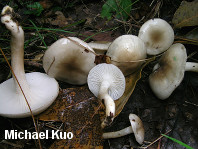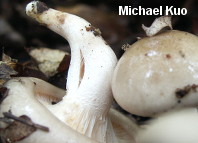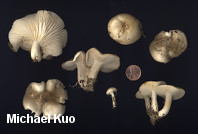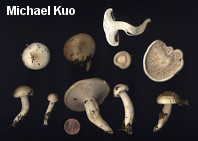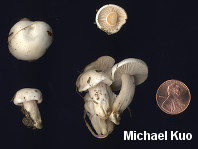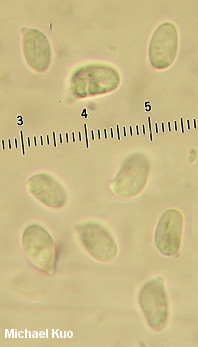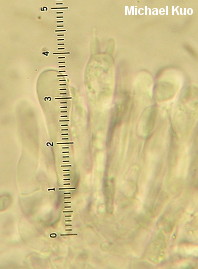| Major Groups > Gilled Mushrooms > Pale-Spored > Waxy Caps > Hygrophorus occidentalis |

|
Hygrophorus occidentalis [ Basidiomycota > Agaricales > Hygrophoraceae > Hygrophorus . . . ] by Michael Kuo Hygrophorus occidentalis appears white when in the button stage, but soon begins to develop grayish brown colors in the center of the cap, and by maturity the cap may be brownish or grayish brown overall--except for the margin, which usually remains paler. It lacks a distinctive odor, and its cap and stem are slimy; these features help distinguish it from some of the other brownish waxy caps. The stem apex is punctuated with tiny white tufts of fibers, but the lower stem lacks the brown-fibrillose "inner veil" found in species like Hygrophorus olivaceoalbus. Young, still-white specimens of Hygrophorus occidentalis can be "scarcely distinguishable" from specimens of Hygrophorus eburneus, according to Hesler & Smith (1963)--but the latter species remains whitish when dried (Hygrophorus occidentalis turns brown), associates with conifers, and features consistently longer basidia. Hygrocybe occidentalis is not a synonym, despite confusion in a few field guides; it is a red species with parallel lamellar trama, found in the tropics. The West-Coast version of Hygrophorus occidentalis may be a separate species, since it is mycorrhizal in ecosystems completely divergent from the eastern North American "oak, maple and pine" forest in southern Michigan where the type collection was made. Description: Ecology: Mycorrhizal with oaks and other hardwoods; growing scattered to gregariously; fall and early winter (and over winter in warm climates); reported as widely distributed in North America, but see the note below about western collections. The illustrated and described collections are from Illinois. Cap: 1-7 cm; convex with an inrolled margin when young, becoming broadly convex or flat; slimy; bald; white to very pale grayish at first, but soon developing gray to brown shades over the center; eventually grayish brown, with the margin typically remaining pale. Gills: Broadly attached to the stem or beginning to run down it; distant or close; white; short-gills frequent. Stem: 2-6 cm long; 3-15 mm thick; equal above, but tapering at the base; slimy, at least over the lower portion; with tiny tufts of white fibers over the dry apex; white or becoming tinged with the cap color; sometimes staining yellowish at the base. Flesh: White; unchanging when sliced. Odor and Taste: Not distinctive. Dried Specimens: Cap, gills, and stem turn brown when dried. Chemical Reactions: KOH golden orange on cap surface (sometimes slowly). Spore Print: White. Microscopic Features: Spores 6.5-9 x 3.5-5 µ; smooth; ellipsoid; hyaline in KOH; inamyloid. Basidia 2- and 4-sterigmate; 35-42 µ long. Hymenial cystidia absent. Lamellar trama divergent. Pileipellis an ixocutis. REFERENCES: A. H. Smith & L. R. Hesler, 1939. (Hesler & Smith, 1963; Smith, Smith & Weber, 1979; Largent, 1985; Lodge et al., 2013; Kuo & Methven, 2014.) Herb. Kuo 09289616, 09300302, 10070304, 09261201. This website contains no information about the edibility or toxicity of mushrooms. |
© MushroomExpert.Com |
|
Cite this page as: Kuo, M. (2014, July). Hygrophorus occidentalis. Retrieved from the MushroomExpert.Com Web site: http://www.mushroomexpert.com/hygrophorus_occidentalis.html |
